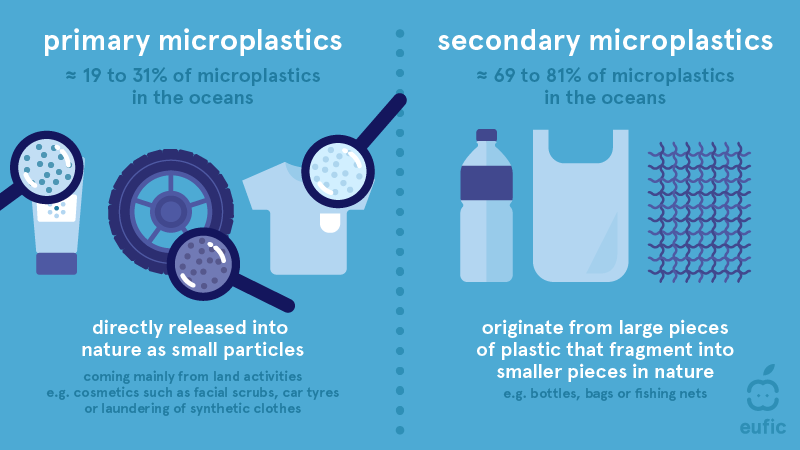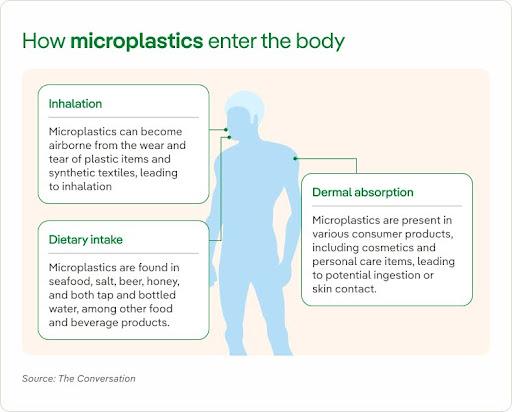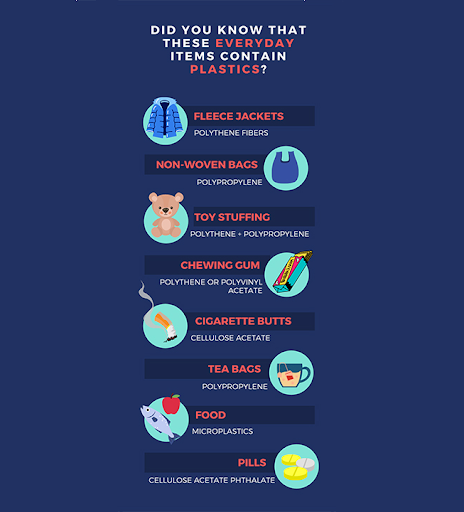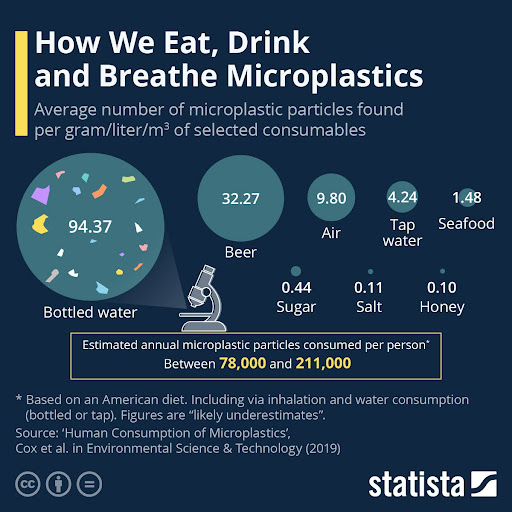Top Microplastics Facts & Stats That Your Family Should Know

Microplastics are tiny but widespread pollutants in our food, water, air, and everyday household products. These small plastic bits are a growing environmental and human health concern.
This article will explore the most surprising facts affecting our everyday lives, including practical steps to reduce risk. Additionally, learn how to reduce your exposure to microplastics, even at home.
What Are Microplastics?
Microplastics are tiny pieces of plastic, generally less than five millimetres, and pose a huge threat to our environment and wildlife. The term "microplastic" was first used in 2004 to describe small pieces of plastic. They are generally solid polymers composed of particles with various additives.
Types of Microplastics
Microplastics are classified into two categories based on their origin: primary and secondary.
Primary Microplastics
Primary microplastics are small pieces of plastic that are intentionally created in a small size for specific applications. They are mostly less than 5 mm in size and are designed to control viscosity, stability, appearance, or abrasive properties in various products.
A few common sources of primary microplastics include:
- Cosmetics and personal care products
- Synthetic textiles
- Industrial products
- Tire wear
- Paints and road markings

Source: eufic
Secondary Microplastics
Secondary microplastics are derived from the degradation of larger plastic debris (macro- or mesoplastics, typically above 5 mm) that's already present in our environment. This degradation occurs through various environmental processes, such as physical, chemical, and biological processes.
The principal processes that result in secondary microplastics are:
Photo-degradation: Exposure to UV radiation from sunlight degrades plastics, breaking them into tiny pieces.
Mechanical Abrasion: Waves and sand in the sea, or friction and wear on land, assist in breaking larger plastic objects into smaller fragments.
Biodegradation and Hydrolysis: Microorganisms are able to decompose polymers, and hydrolysis (which is a water reaction) can also be utilised to degrade them.
Why Microplastics are Difficult to Avoid
Microplastics pose a significant challenge to avoid due to their widespread presence, various sources, and distinct characteristics.
Ubiquitous Presence
Microplastic pieces are everywhere — in the air, water, food, and water bodies — and enter our bodies in many ways. They even occur in distant areas far from human reach, such as the Arctic Ocean.
Diverse Origins
Microplastics have diverse primary and secondary sources. That’s why tracing their possible entry points into our world and lives is difficult.
Ineffective Filtration Mechanisms
Wastewater treatment plants are not usually designed to trap such small particles. This is why many microplastics escape and find their way into aquatic systems.
Longevity and Accumulation
Plastics are usually non-biodegradable and are likely to accumulate in the environment. Once they are out, they last for a long time, and it becomes very difficult to remove them.
Complexity and Variability
Microplastics vary in shape, size, colour, density, and chemical composition. These factors make detection, characterisation, effective removal and treatment processes more complex.
Ingestion and Inhalation Pathways
People encounter microplastics primarily through consuming food and drinking water contaminated with microplastics, as well as through breathing air and dust contaminated with microplastics. Food packaging made of plastic is so common that it is very difficult to avoid it.

Source: Iberdrola
Invisible Danger
Most microplastics, especially nanoparticles, cannot be seen with the naked eye. It means it is harder for individuals to notice they are present and take measures to avoid exposure.
Surprising Places Microplastics Are Found in the Home
Microplastics are everywhere in our homes, appearing in many unexpected places. These tiny particles are formed when larger plastic products break down and can gather in the air, water, and soil, as well as inside our bodies.
Numerous common household items lead to microplastic exposure, often without us realising it. These are usually found in:
Clothing and Textiles: A major contributor to microplastics in our homes is clothing, with around 60% to 70% of garments. They are usually made from plastic fibres such as polyester, nylon, and acrylic.

Source: Mongabay
Personal Care Products and Cosmetics: Microbeads, which are tiny plastic particles, can still be found in various personal care products, especially cosmetics like mascara, foundation, face powders, and lipstick, even though some exfoliants and toothpaste have been banned.
Kitchen Products: These kitchen items include tea bags, chewing gum, disposable coffee cups, kitchen sponges, food containers, and cans. It also contains non-stick cookware, utensils, and spices in plastic packaging.
Other items: There are also other items that contain microplastics that you might not know. These include receipts, glitter, wet wipes, dental floss, toothbrushes, and toys.
Spaces in the Household with Higher Microplastic Concentrations
Interior rooms typically present higher concentrations of microplastics compared to exterior areas. Factors like interior furnishings and clothing contribute heavily to higher airborne microparticles indoors.
Some areas in a house that are likely to contain higher microplastic concentrations include:
Kids' Bedrooms: These rooms often have higher microplastic levels, particularly due to carpets, non-cotton bedding, and stuffed toys.
Carpeted Rooms: According to studies, carpeted rooms absorb polyamide (PA), polyethylene (PE), polystyrene (PS), polyester, and polyacrylic microplastics in the dust.
City Houses: Houses in metropolitan areas with more complex interior spaces tend to be more contaminated than those in rural areas.
Residential Areas: Although the levels of indoor air microplastics are typically low, ranging from 1.6 to 9.3 particles per cubic meter, residential areas can accumulate significant amounts.
High Activity Rooms: Indoor levels of microplastics depend on activities and the number of individuals within a room. For example, offices and schools have also indicated increased microplastic levels accumulated on weekdays compared to weekends.
Microplastics in Food & Water: What the Stats Say

Source: Statista
It was estimated that, on average, an individual approximately ingests 5 grams of microplastics a week. This is much smaller, around 25,000 times lower than the most conservative of the original Newcastle estimates and more than a million times lower than 5.5 grams.
The results of this study revealed that a human being does not ingest a week's worth of microplastics contained on the equivalent of one credit card, but rather about once every 23,000 years.
The estimated yearly microplastic consumption is between 74,000 and 121,000 particles for both ingestion and inhalation.
Other Food Sources
Bottled Drinking Water: A study showed that bottled drinking water contains an average of about 240,000 small plastic pieces, 90% of which are nanoplastics.
Seafood: Microplastics occur in the edible parts of fish and shellfish. Filter-feeding shellfish can ingest more microplastics than other types of seafood.
Salt: Microplastic pollution has been found in sea salt from various parts of the world.
Fruits and Vegetables: Microplastics can enter fruits and vegetables through plant absorption via their root structures, which are grown in soil or fertilised with fertilisers that contain microplastics.
Beer and Wine: Microplastics have been found in beer and certain wines that come with polyethylene stoppers.
Tea Bags: Most modern tea bags, particularly those in pyramid shapes, are made with polypropylene and release billions of microplastics and nanoplastics into hot beverages.
Simple Ways to Reduce Microplastic Exposure at Home
Focus on making practical changes to your daily routines to minimise your exposure to microplastics. Even small changes can significantly reduce your overall exposure in the long run.
Refuse Microwaving in Plastic: Microwaving food or water in plastic bowls, even those labelled as "microwave-safe," can cause microplastics and chemicals to seep into your food. Instead of microwaving in plastic, heat food in ceramic or glass bowls.
Use Glass or Stainless Steel Containers: Switch to glass or stainless steel containers instead of plastic food storage containers. They do not leach chemical pollutants or microplastics into your food, particularly when heated. Stainless steel containers are long-lasting, eco-friendly, and safe for the long term, while glass allows you to see what is inside.
Select Natural Fabrics: Synthetic materials such as polyester, nylon, and fleece shed microplastics when laundered and worn, which might be inhaled or released into sewage. Instead, select clothing and furniture made of natural fibres like cotton, wool, linen, or silk.
Use Water Filtration: Consumption of bottled water is a chief cause of microplastic exposure. Using filtered tap water can effectively decrease your microplastic intake. NSF-certified water filters are tested for their ability to remove microplastics.
Vacuum with HEPA Filters: Microplastics may be present as dust in the air indoors. Use a vacuum cleaner with a HEPA (High-Efficiency Particulate Air) filter. It can effectively remove at least 99.97% of particles that are 0.3 microns or larger, many of which are microplastics.
Hand-Wash Plastic: Hand-washing plastic food containers is safer than dishwashers, which use extremely high temperatures. The extreme temperature can dissolve plastic even when marked "dishwasher-safe" and lead to microplastic shedding.
Choose Wood or Bamboo Cutting Boards: Replace your plastic cutting boards with wood or bamboo cutting boards to reduce microplastic exposure.
Identify areas in your home where plastic is prevalent and consider replacing those items with non-plastic alternatives. Although it is virtually impossible to eliminate microplastics entirely because of their pervasiveness, following these prudent measures can significantly minimise your exposure and enhance your overall health.
What Role Does Rubbish Removal Play in Reducing Microplastics?
Reducing microplastic exposure at home means disposing of plastic correctly. Proper rubbish removal prevents it from degrading into microplastics that contaminate landfills and water bodies.
Landfills account for a significant portion of microplastic contamination because plastic waste degrades over time, releasing microplastics into the surrounding environment.
The degradation smears soil, groundwater, and surface water through leachate. About 8 to 10 million metric tonnes of plastic enter the ocean annually, representing 80% of the total marine pollution.
To minimise exposure to microplastics and avoid their creation, you can:
- Stop using single-use plastics
- Restrict processed foods
- Select non-plastic options
- Use loose-leaf teas
- Enhance laundry practices
- Vacuum
- Properly dispose of plastic
- Wash plastic manually
- Engage in cleanups
All Gone Rubbish Removals ensures that plastics are separated, recycled, or disposed of safely and environmentally friendly. Our professional removalists sort through trash and deliver recyclable products to a recycling plant for reuse or repurposing.
We aim to reduce the amount of plastic waste that will eventually disintegrate into microplastics. Our team of professionals follows the "5 Rs" of waste management and assists both businesses and residential customers by encouraging a reduction in plastic use.
We provide same-day rubbish removal services across Sydney, the Central Coast, Gosford, Newcastle, and the Gold Coast. Call us and book our service before 2 pm for your area's best-priced rubbish removal service!
Key Microplastics Statistics You Should Know
Microplastics are a worldwide problem, and everybody must know these statistics. Check out these facts:
Microplastics in Bottled vs. Tap Water
Based on a January 2024 study, bottled water is likely to contain an average of 240,000 plastic particles per litre, of which 90% are nanoplastics. Tap water samples across the globe, however, have microplastics ranging from 0.01 to 9.24 particles per litre.
Global Plastic Production Figures
- The annual world production of plastic increased from 2 million metric tonnes (Mt) in 1950 to 400 Mt in 2022 at an average annual growth rate of 8.4%.
- The world's total plastic production in 2023 was 413.8 million metric tonnes, while the total production of plastics was approximately 415 million metric tons.
- Global mechanical plastic recycling will generate microplastics, which will rise from 41 kt in the year 2000 to 1,397 kt by 2060.
Average Household Plastic Waste in Australia
- An average Australian household produces more than 12.4 million tonnes of waste annually, and each person makes about 540 kg of household waste per annum.
- Australian plastic waste enters water bodies and oceans at the rate of 130,000 tonnes annually.
- Only 20% of household plastic waste in Australia is recycled.
- Within a minute, Australians produce one tonne of plastic waste.
- Between the years 2022–23, around 2.99 Mt (114 kg per capita) of plastic waste was generated in Australia, excluding plastics in textiles and tyres.
- Around 84% of plastic waste in Australia goes to landfill.
- About 15% of all plastic waste generated in Australia over the past two decades has been recovered through recycling, composting, or energy recovery.
Statistics on Microplastics in the Air and Oceans
- Microplastic concentrations of outdoor air can range extensively from less than 1 to over 1,000 microplastics per cubic metre.
- Indoor air normally contains greater concentrations of microplastics than outdoor air, with concentrations ranging from 1.6 to 12.6 microplastics per cubic metre.
- An estimated adult would breathe in about 6,351 microplastics a year, using an estimated 1 MP/m³ and a breathing volume of 17.40 m³ daily.
- Plastic flows into the ocean at a rate of roughly 8 to 10 million metric tonnes a year, which accounts for 80% of all marine pollution.
- If the ongoing trends keep going, it is estimated that by the year 2050, more plastic will be in the oceans than fish.
For information on the impact waste can have on Australia, click here.
Frequently Asked Questions
1. How do microplastics get into our food and water?
Microplastics are introduced into our water and food through different ways, like air, water, land, and the food we consume, including the marine animals (fish and molluscs).
2. Are children more affected by microplastics?
Precisely! Children are considered more vulnerable to the effects of microplastics than adults. The increased vulnerability is due to their specific behaviour, growing bodies, and higher exposure levels based on their body weight.
3. Can microplastics be filtered out of water?
Yes, it is possible to remove microplastics from water through various techniques and technologies. Each technology differs in performance depending on the kind of filter applied and the size of the microplastics.
4. What are the most common sources of microplastics in the home?
The primary sources of microplastics found in households are:
- Textiles and Clothing (e.g., bedding, synthetic fibres, and laundry practices)
- Household Dust
- Kitchen and Food-Related Items (e.g., tea bags and food packaging)
- Personal Care and Cleaning Products (cosmetics, dental hygiene products, and cleaning products)
- Other Household Items and Activities (dryer lint, dryer sheets, 3D printing, paints)
5. How can rubbish removal reduce microplastic pollution?
Rubbish removal prevents microplastic pollution by stopping plastic trash from contaminating the environment and disintegrating into smaller pieces.
- Is Fibro Asbestos? Understanding The Difference - July 14, 2025
- Household Hot Water Tank Disposal in Sydney - July 14, 2025
- Garage Clean Out & Clearance Services Sydney - July 14, 2025
